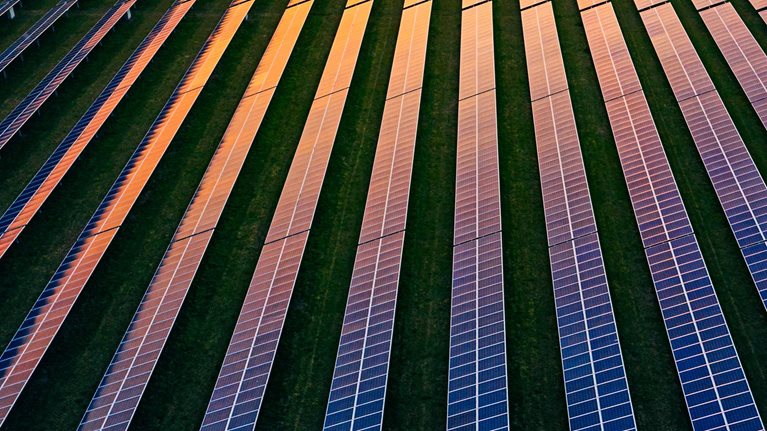The rapid maturation of wind and solar power has been nothing short of astonishing. Not long ago, the development of new solar and wind farms was typically driven by small regional players, and the cost was significantly higher than that of a coal plant. Today, the cost of renewables has plummeted, and many solar and wind projects are undertaken by large multinational companies, which often also announce staggering development targets.
Over the past decade, the growth of renewable energy has consistently and dramatically outperformed nearly all expectations (Exhibit 1). Upward corrections of estimates have become something of a ritual.

But this growth story is just getting started. As countries aim to reach ambitious decarbonization targets, renewable energy—led by wind and solar—is poised to become the backbone of the world’s power supply. Along with capacity additions from major energy providers, new types of players are entering the market (Exhibit 2). Today’s fast followers include major oil and gas companies, which aim to shift their business models to profit from the increased demand for renewables and the electrification of vehicles, and private-equity players and institutional investors that make renewable energy a central component of their investment strategy. Leaders in the shipping industry are investing in renewables to enable the production of hydrogen and ammonia as zero-emission fuel sources; steel manufacturers are eyeing green hydrogen to decarbonize their steel production, with renewables providing the green electricity for the process. Car manufacturing companies are also striking renewable-energy deals to help power their operations and manufacturing, as well as making investments in wind and solar projects.

McKinsey estimates that by 2026, global renewable-electricity capacity will rise more than 80 percent from 2020 levels (to more than 5,022 gigawatts).1 Of this growth, two-thirds will come from wind and solar, an increase of 150 percent (3,404 gigawatts). By 2035, renewables will generate 60 percent of the world’s electricity.2 But even these projections might be too low. Three years ago, we looked at advances made by renewable energy and asked, “How much faster can they grow?”3 The answer is: faster than you think they can.
Three core capabilities for wind and solar developers
This race to build additional solar and wind capacity increases the pressure on developers to execute efficiently and heightens competition for finite resources. Still, the three winning capabilities we identified three years ago as important for building or expanding a renewables business are even more critical now. They form the bedrock required to tackle upcoming challenges:
- Value-chain excellence. As competition intensifies and government support for renewables subsides, strong capabilities across the entire value chain are the required cost of admission. For instance, gaining access to scarce amounts of attractive land will require differentiation in project origination and development. As margins squeeze and operators’ exposure to risk increases, ambitious companies will want to explore new, profitable offtake markets for their electricity, such as data centers or hydrogen electrolyzers for industrial production.
- Economies of scale and skill. Driven by the rapid scaling of the renewables industry, many players have built efficient operating models. However, finding employees with the necessary skills and capabilities, particularly in high-demand areas such as project development and engineering, is becoming a bottleneck for growth ambitions.
- Agile operating model. Agility and speed will be key in finding innovative ways to integrate partners and in establishing robust, high-performing supply chains. They will also enable businesses to shift resources quickly to the biggest value pools and respond to changes in the landscape, such as shifting regulations or price volatility.
Four challenges that will define the new era of renewable energy
Leveraging these capabilities as a strong foundation, successful renewables developers must navigate an increasingly complex and competitive landscape. Specifically, they will have to focus on and address four emerging challenges:
- A scarcity of top-quality land. Developers are in a constant scramble to identify new sites with increasing speed. Our analysis in Germany, a country aiming to nearly double its share of electricity coming from renewables by 2030, offers a glimpse into the constraints. Of the 51 percent of the country’s land that is potentially suitable for onshore wind farms, regulatory, environmental, and technical constraints eliminate all but 9 percent.4 Meeting capacity targets will mean adding wind turbines to 4 to 6 percent of the country, giving developers very little room for error.
- A blue-collar and white-collar labor shortage. Across economies, the “Great Attrition” is making it difficult for companies to find and keep employees. Since April 2021, 20 million to 25 million US workers have quit their jobs, and 40 percent of employees globally say they are at least somewhat likely to leave their current position in the next three to six months.5 This environment presents a particularly acute challenge for industries such as renewable energy, where specific technical expertise and experience are crucial elements of success. For instance, our analysis suggests that between now and 2030, the global renewables industry will need an additional 1.1 million blue-collar workers to develop and construct wind and solar plants, and another 1.7 million to operate and maintain them.6 This includes construction laborers, electricians, truck and semitrailer drivers, and operating engineers.
- Supply chain pressures. The soaring cost of steel, manufacturing disruptions caused by extended lockdowns in China, and transportation backlogs at ports are already making it difficult for wind and solar developers to complete projects in their pipeline on time and on budget. Some of these pressures will abate as others move to the forefront. For instance, many of the raw materials needed to manufacture solar panels and wind turbines are projected to be in short supply. This includes nickel, copper, and rare earth metals such as neodymium and praseodymium, which are indispensable for the creation of magnets used in wind turbine generators.
- Pressure on profits and volatility of returns in the short term. The increasing number of players moving into the renewable-development space, combined with reduced levels of government support and higher costs of materials, technology, and financing, is putting pressure on returns. At the same time, an all-time-high price volatility creates uncertainty and market risk.
Renewables developers will need to act decisively to prepare for these upcoming challenges. In a series of future articles, we provide detailed insights on each of these pressures and share potential ways players can take action.


